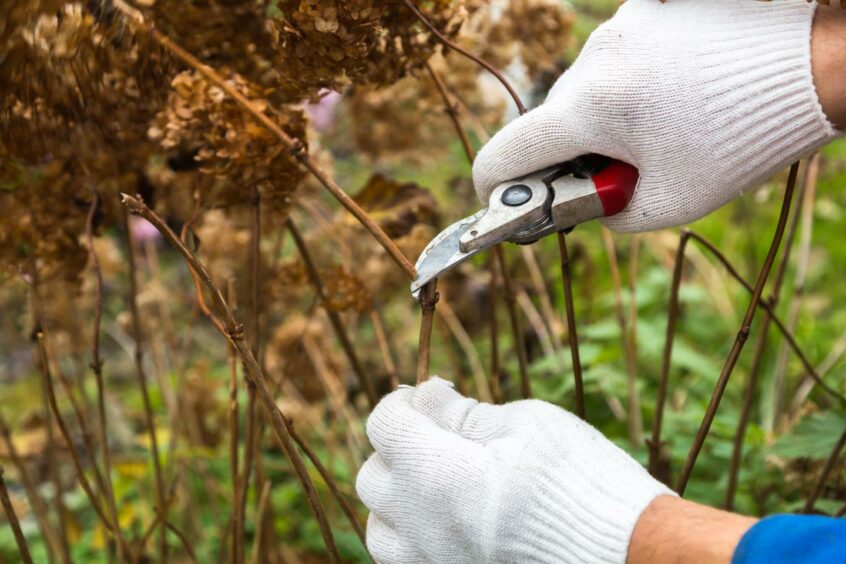During one of the drier spells last week, I had the secateurs out to do a bit of “rough” pruning of some of our shrubs.
By that I mean shortening lengthy and whippy branches which might be damaged by these strong winds we have been getting recently.
No botanical knowledge required at this stage other than to remind you to make cuts just above a leaf joint (because that is where the wound heals over quickly) but my intention is to prune them properly before growth starts in the early spring.
Hydrangeas
Whilst one or two shrub roses were on my list, it was the gorgeous hydrangea Vanille Fraise came top.
I have spoken before about this delightful, comparative newcomer to the hydrangea family.
The question is asked on a regular basis: “Read your column, remind me again how to prune hydrangeas.”
Hydrangeas have been good performers again this year, some are still showing a lot of colour and here we are in mid-November.
Vanille Fraise, for example. The fact is, because we grow a range of different species of hydrangea in our gardens, flowering at different times, we need to adjust our pruning accordingly.
The general rule, which I apply to most flowering shrubs, is quite simple: in this part of the world, if it flowers up to June, prune immediately after because there is the rest of the summer for the plant to make new growth.
If the shrub flowers after June and into autumn, prune in late winter/early spring the following year.
Mop-headed varieties
The most common group of hydrangeas, the so-called mop-headed varieties, are in the hydrangea hortensis group.
Popular in our garden borders, they are also presented as pot plants, ideally suited for the porch or conservatory.
I notice some folks leave the withered heads on the plants over winter because they like the look.
If you don’t, there is no harm in taking them off.
That said, removal of the old flower heads with a significant length of stem makes space for the developing new shoots to be left untouched.
They will develop fat, healthy buds at the top – the so-called terminal bud which will produce next year’s flowering head.
(In this case “terminal” meaning at the end of the stalk, not the end of its life!)
Encourage new growth
As bushes mature however, there is likely to be a build-up of older, unproductive wood in which case it should be thinned out near to the base to encourage new growth.
This can be done in late autumn or April in the new year. After a year or two of this schedule, plants attain a certain equilibrium and the intensity of pruning can be reduced somewhat.
There is much to be said for this minimalist approach because after all, the most reliable specimens seem to be those that have almost naturalised around the coasts of the UK and no one prunes them at all.
I would make three comments about that; firstly, if they have naturalised successfully then they have found their ideal environment; secondly, you hardly notice if some of the plants have an “off” year, whereas that one plant in your garden border is under constant scrutiny and isn’t expected to have a bad year – ever.
Finally, space in the private garden is often limited and more intensive pruning helps to keep the plant within bounds.
That type of pruning described is characteristic for plants that start to flower from early summer onwards.
These varieties belong to the H macrophylla species, sometimes referred to as the Hortensia group which includes Lacecaps.
Conical flowers
There is another hydrangea, which starts to flower in the second half of the summer, hydrangea paniculata, the most popular being the majestic Grandiflora.
The flowers tend to be conical in shape, white to begin with and gradually turning pink.
The variety Vanille Fraise belongs in the H paniculata species. To be brief, this group of shrubs can be pruned back to about 30cm in April.
They are quite vigorous growers, and if you want your plant to fill a bigger space, don’t cut back quite so far.
Observations and statistics
Just a thought or two. In trying to keep up with the effects of climate change, highlighted of course by the goings-on in Glasgow, I picked up some very odd observations and statistics.
Firstly, under the heading of Urban Agriculture – developing horticulture that delivers local employment, reduces food miles whilst supplying locally-grown food for local people.
Achieved by encouraging market gardening around towns and cities.
I just knew it would come back into fashion. I did my “apprenticeship” on one of them, getting there on my bike. What goes round…
Here’s a better one, back to the tree theme again.
If every gardener planted a medium-sized tree they would store enough carbon to drive 11.4 million times round the planet.



